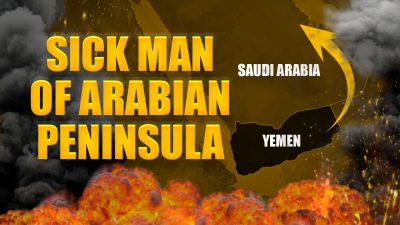Video: Saudi Regime on Brink of Collapse? Economic Crisis and Setbacks in Yemeni War

Saudi Arabia has become a hostage of its own military campaign in Yemen. The Kingdom suffers from both its own inability to achieve a military victory in the conflict and regular losses from the retaliatory actions of the Houthis. At the same time, the Saudi leadership has no opportunity to withdraw from the conflict and abandon its proxies there because this will undermine its already shaky position in the region and cause a wide-scale political crisis inside Saudi Arabia itself. The impact from such a crisis will be especially devastating.
Over the past years, the Kingdom has been passing through turbulent times due to the economy slowing down and the acute struggle for power within the Saudi elites. In 2020, with the global economic crisis and the COVID-19 outbreak, the situation inside Saudi Arabia became even more complicated.
On July 13, the Houthis announced that they had conducted a new combined missile and drone strike on targets inside the Kingdom. According to Brigadier General Yahya Sari, a spokesman for the Armed Forces of the Houthi government, the strikes hit the following targets:
- positions of US-made Patriot missile systems, warplanes’ shelters and the housing complex for pilots at Khamis Mushait;
- military sections of Abha, Jizan and Najran airports;
- the oil infrastructure in Jizan.
Additionally, Brigadier General Sari said that missiles and drones hit the Saudi-operated Tadawin camp in the Yemeni province of Marib during the meeting between Saudi officers and leaders of Saudi-backed forces. Dozens of members of Saudi-led forces were killed and injured in the attack, according to Brigadier General Sari.
The Houthis warned that they will continue their strikes on Saudi Arabia utill the end of the Saudi-led blockade of Yemen. This is the second Houthi strike on targets inside the Kingdom in less than a month. On June 23, Houthi forces launched missiles and drones at military targets near the Saudi capital of Riyadh.
Commenting on the July 13 incident, the Saudi military claimed that it had intercepted 8 “booby-trapped” drones and four ballistic missiles launched towards Saudi Arabia. The coalition often denies any losses or casualties as a result of Houthi strikes and works to censor data appearing through social media networks. However, results of the previous Houthi strikes and the success rate of Patriot missile systems deployed in Saudi Arabia are a sign that this statement may be an ordinary attempt to cover yet another military failure.
On July 1, Saudi Arabia announced the start of a new air bombing campaign to neutralize and destroy the offensive capabilities of the Houthis, first of all its missile and drone arsenal. Since then, multiple Saudi airstrikes have hit the provinces of Saada, Ma’rib, al-Jawf, Hajjah, al-Bayda as well as on the Yemeni capital of Sanaa. Many of the hit targets were located in urban areas. The Saudi coalition provided few details regarding the targets destroyed.
On July 2, Col. Turki al-Maliki, a spokesman for the coalition, declared that the first round of airstrikes destroyed ballistic missile and drone storage facilities, assembly workshops and communication stations of the Houthis. On July 3, the coalition announced that its warplanes had destroyed two booby-trapped boats 6km south of Salif Port in the province of al-Hudaydah.
The Houthis slammed Saudi claims as propaganda claiming that most of the bombed targets were civilian ones. In particular, Brigadier General Sari said the July 3 strike hit fishing boats and a salt factory. The July 13 strike on Saudi Arabia contributes to the version that the Saudi coalition at least overestimated results of its bombing campaign.
At the same time, the Houthis continued successful offensive operations against Saudi-backed forces in the provinces of Marib and al-Bayda.
In the current conditions, the further development of the conflict creates a real threat that the Kingdom’s leadership will not only loose the campaign in Yemen, but will struggle to deal with a Houthi offensive in the south of Saudi Arabia. Such a scenario may eventually lead to the collapse of the current Saudi regime.
*
Note to readers: please click the share buttons above or below. Forward this article to your email lists. Crosspost on your blog site, internet forums. etc.
SUPPORT SOUTHFRONT:
PayPal: [email protected], http://southfront.org/donate/ or via: https://www.patreon.com/southfront

